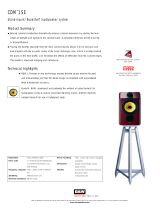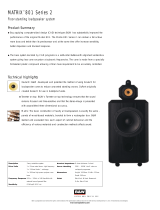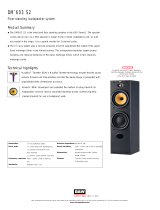Page is loading ...

1
O W N E R ' S M A N U A L
PAL-380 Precision Architectural Loudspeakers
www.parasound.com

2
Introduction
Congratulations on your purchase of your PAL-380 Precision Architectural Loudspeaker
system and thank you for choosing Parasound. The PAL-380s were developed using the
finest loudspeaker and crossover components available. Countless hours of computer modeling
were spent to insure accurate audio reproduction in a variety of installations where placement
compromises must sometimes be made. The PAL-380 Precision Architectural Loudspeakers
deliver the high-fidelity audio reproduction you have come to expect from high-end
loudspeakers in a cabinet. Please take a few minutes to read these instructions thoroughly to
make the installation easier and insure optimum performance.
Unpacking and Inspection
Carefully unpack your PAL-380 loudspeakers locate the enclosed accessories:
Qty Description
2 PAL-380 baffle and loudspeaker assembly
2 Removeable bezels with mounting dogs
2 Metal grilles
6 #8 x ∫” screws
6 Rubber shoulder washers
2 Foam grille inserts
Be sure to carefully inspect the speakers for any signs of shipping damage. If you notice any,
contact your Parasound Dealer immediately.
Precautions
If you have any doubts about your ability to properly install in-wall loudspeakers, you should
consider the services of a custom installer. If you plan to install them yourself, always use
good quality tools to save time and make the installation go more smoothly.
The PAL-380 Precision Architectural Loudspeakers mount into standard 4 inch (or greater)
stud depth walls. Determine the final location of both left and right speakers before cutting
any holes since changes to one speaker may affect the other either aesthetically or acoustically.
Look for pipes, wiring or any other conflicting material that might be damaged before
beginning the installation.
Prewiring
Before you purchase loudspeaker wire, check local building codes to make sure that the
wire is rated to comply with applicable local safety codes such as UL or CL-2. Use only
stranded wire no thinner than AWG 16. For runs longer than 100 feet, we recommend
minimum of AWG 14. When pulling wire, take care not to pull the wire too fast to prevent
stretching the wire or scorching the insulation from friction. Leave 2 to 3 feet of excess
loudspeaker wire at both ends; it is easier to trim off excess wire than to splice additional
wire. When securing the wire inside the walls, be careful not to pierce the insulation with
nails or staples.

3
For best performance and easier troubleshooting, always “home run” wiring when installing
multiple speakers rather than connecting from one speaker to the next. When connecting
multiple speakers, make sure that the power amplifier is capable of adequately driving the
combined impedance of the speakers. If not, you may need additional amplifiers or an impedance
protection device that are often built into loudspeaker selection boxes.
Mirror Image Midrange and Tweeter Assembly
The PAL-380 midrange and tweeter assembly are mirror imaged so you can position them
for best sonic imaging. Ideally, the listening position should be at one point of an equilateral
triangle with the left and right speakers positioned at the other two points. If you need to
mount the speakers outside this idealized equilateral triangle, position the tweeters toward the
middle. If you need to mount the speakers inside this idealized equilateral triangle, position
the midrange drivers toward the middle.
Installing the PAL-380 Precision Architectural Loudspeakers
1. Confirm that there is at least 1 1/2" of clearance between each edge of the planned
cutout and adjacent studs or joints.
2. Fasten the supplied cardboard template to the wall or ceiling with tape or thumbtacks.
Check again for equal distance of both speakers from the ceiling or floor.
3. Use a level or the included template’s self-leveling feature so the cutout will be level.
4. Trace around the perimeter of the template.
5. Before making the final cutout, make a small 6-inch square “test cutout” in the center of
the penciled outline. Reach inside the test hole to verify that there are no obstructions in
the way of your planned cutout.
6. Before cutting the hole, first score the drywall with a razor knife and use a keyhole saw
to complete the cut. Remove debris from the edge of the hole.
7. Secure the speaker wire to a stud near the cutout so its weight will not tug on the terminals
of the speaker after it is connected. This also keeps the wire from dropping behind the
wall before you can connect it.
8. Terminate the speaker wire with 1/4" spade lugs or banana plugs. You can also insert
bare wire up to AWG 12 into the holes on the sides of the binding posts.
9. Carefully separate the removable bezel from the baffle and loudspeaker assembly. The
bezel can be mounted in the wall and painted if desired while the main part of the
loudspeaker is stored away safely until you are ready to mount it. Note: The grilles
should be painted separately rather than while mounted in the separate bezel.
10. Insert the PAL-380 bezel into the cutout to make sure it fits easily without forcing.
11. Evenly tighten the mounting screws on the bezel. The mounting “swing-arms” (also known
as mounting “dogs”) will automatically swing out 90 degrees. After they swing out, the
arms then clamp against the drywall from behind the wall. Avoid using excessive force to
prevent deforming the drywall or cracking the speaker’s mounting frame.
12. We recommend that you add a “blanket” of sound absorbing material such as ceiling
insulation behind the woofer to reduce sound transmission into the adjoining room.
Additionally, any sound leakage from behind the molded frame can be blocked with
foam weather-stripping directly behind the plastic speaker bezel.
13. Install the main loudspeaker assembly into the bezel.
14. Install the six rubber shoulder washers into the holes in the bezel
15. Use the six supplied #8 x ∫” screws to fasten the loudspeaker assembly into the bezel.

4
Pre-Drilled Hole for Infrared Receivers
The PAL-380 has a 1/2" hole in the bezel to accommodate an infrared receiver such as the
Xantech Video Link model 490. The hole can be easily accessed by removing the rubber
bushing from the rear of the bezel. If you plan to hide an infrared receiver behind the
loudspeaker grille, be sure to pre-wire a three conductor control wire along with the speaker
wire.
Removing the Loudspeaker Assembly from the Bezel
Gently push the lower portion of the pivoting midrange and tweeter assembly until it is at
its full 15-degree downward position. This allows access for your fingers to reach inside
the baffle and loudspeaker assembly and pull it away from the bezel.
Adjusting the Pivoting Midrange and Tweeter Assembly
The PAL-380 employs a pivoting midrange and tweeter assembly. You can adjust this
assembly so the midrange and tweeter are pointing toward the listening position regardless
of how the PAL is mounted in the wall. Gently push upper or lower portion of the pivoting
midrange and tweeter assembly to aim it at the desired position.
Fine Tuning the Frequency Response of Your Loudspeakers
Three Position Treble Adjustment
The PAL-380 treble adjustment switch allows you to adjust the tweeter level from 0 dB
(flat) to -3 dB or + 3 dB. If you are mounting the speaker in a “live” room with many
reflective surfaces, you may want to attenuate the treble response and tame sibilance. If you
are mounting the speaker in a room with many absorptive surfaces, you may want to boost
the treble response.
Three Position Midrange Adjustment
The PAL-380 midrange adjustment control allows you to adjust the midrange level from 0
dB (flat) to -3 dB or + 3 dB. If you want bring out vocals and midrange instruments and
make the speaker sound a little “forward” set the Mid switch to the +3 dB position. If you
want tone down vocals and midrange instruments and make the speaker sound a little “laid-
back” set the Mid switch to the +3 dB position.
Two Position Mid-Bass Contour Adjustment
The PAL-380 mid-bass adjustment switch allows you to attenuate the mid-bass response
from 0 dB (flat) to -3 dB. If you mounted the PAL-380 near a corner of a wall, you may
notice additional boominess of the bass response. You can attenuate the mid-bass response
by setting the Mid Bass switch to the -3 dB position.
High
Mid
Mid
Bass

5
Swing arms in
retracted position
Swing arms in locked
and mounted position
PAL-380 Removable Bezel
High
Mid
Mid
Bass
PAL-380 Precision Architectural Loudspeaker
PAL-380 Baffle and Driver Assembly
Kevlar Woofer
with Phase Plug
Aluminum
Tweeter
Soft Dome Midrange
Tone Adjustment Switches
Pivoting Midrange
and Tweeter Assembly
IR Receiver Access Hole

6
PAL-380 Precision Architectural Loudspeaker Specifications
Frequency Response 36 Hz-22 kHz +/- 2 dB
Nominal Impedance 6 Ohms
Minimum Impedance 4 Ohms
Sensitivity 1 Watt/1Meter 89 dB
RMS Power Range 10-100 Watts
Woofer Size 8"
Cone Material Kevlar
Surround Material Polyurethane
Midrange Size 2” Soft Dome
Tweeter Size 1 " Aluminum Dome
Midrange and Tweeter Assembly Pivoting Dual-Chamber for Lower Crossover Points
Crossover Frequencies 500 Hz, 2.4 kHz
Crossover Slope 12 dB per octave
Dimensions
Hole Cut-Out 8 5/8" x 12 3/4"
Outer Edge of Frame 10" x 14"
Optional Accessories
Rough-In Kit NC/K-8M
Parasound Products, Inc. 950 Battery Street, San Francisco, CA 94111
415-397-7100 / FAX 415-397-0144 www.parasound.com
© 1999 Parasound Products, Inc. Rev 0.9
/



